Advanced Financial Accounting Report: Climate Change and NZ ETS
VerifiedAdded on 2023/01/10
|13
|1686
|91
Report
AI Summary
This report delves into advanced financial accounting, focusing on the implications of climate change and the New Zealand Emissions Trading Scheme (NZ ETS). It examines the role of corporations in addressing climate change, exploring cap and trade schemes and their accounting treatment. The report analyzes the NZ ETS, its objectives, and its potential impact on Pumkin Ltd, an agricultural company. It discusses the company's obligations, such as forest preservation and carbon emission reduction, and the opportunities, including financial incentives. The report highlights the importance of corporate responsibility in environmental issues and the impact of climate change on financial reporting. It also incorporates an analysis of consolidated financial statements, inter-group transactions, and the effects of climate change on a company's going concern concept. The report concludes that companies must reduce carbon emissions and invest in environmental initiatives while considering the impact on their financial performance.
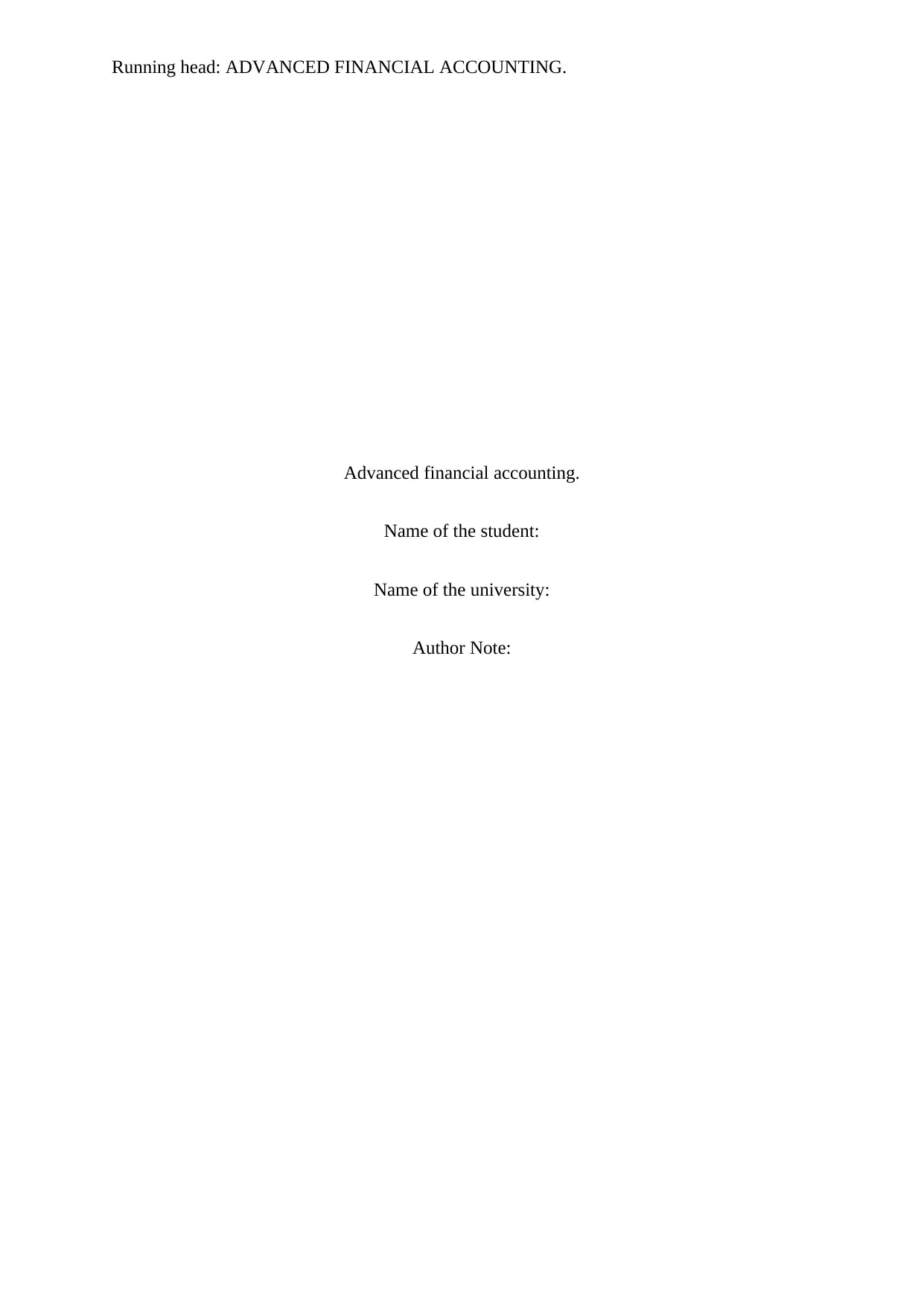
Running head: ADVANCED FINANCIAL ACCOUNTING.
Advanced financial accounting.
Name of the student:
Name of the university:
Author Note:
Advanced financial accounting.
Name of the student:
Name of the university:
Author Note:
Paraphrase This Document
Need a fresh take? Get an instant paraphrase of this document with our AI Paraphraser
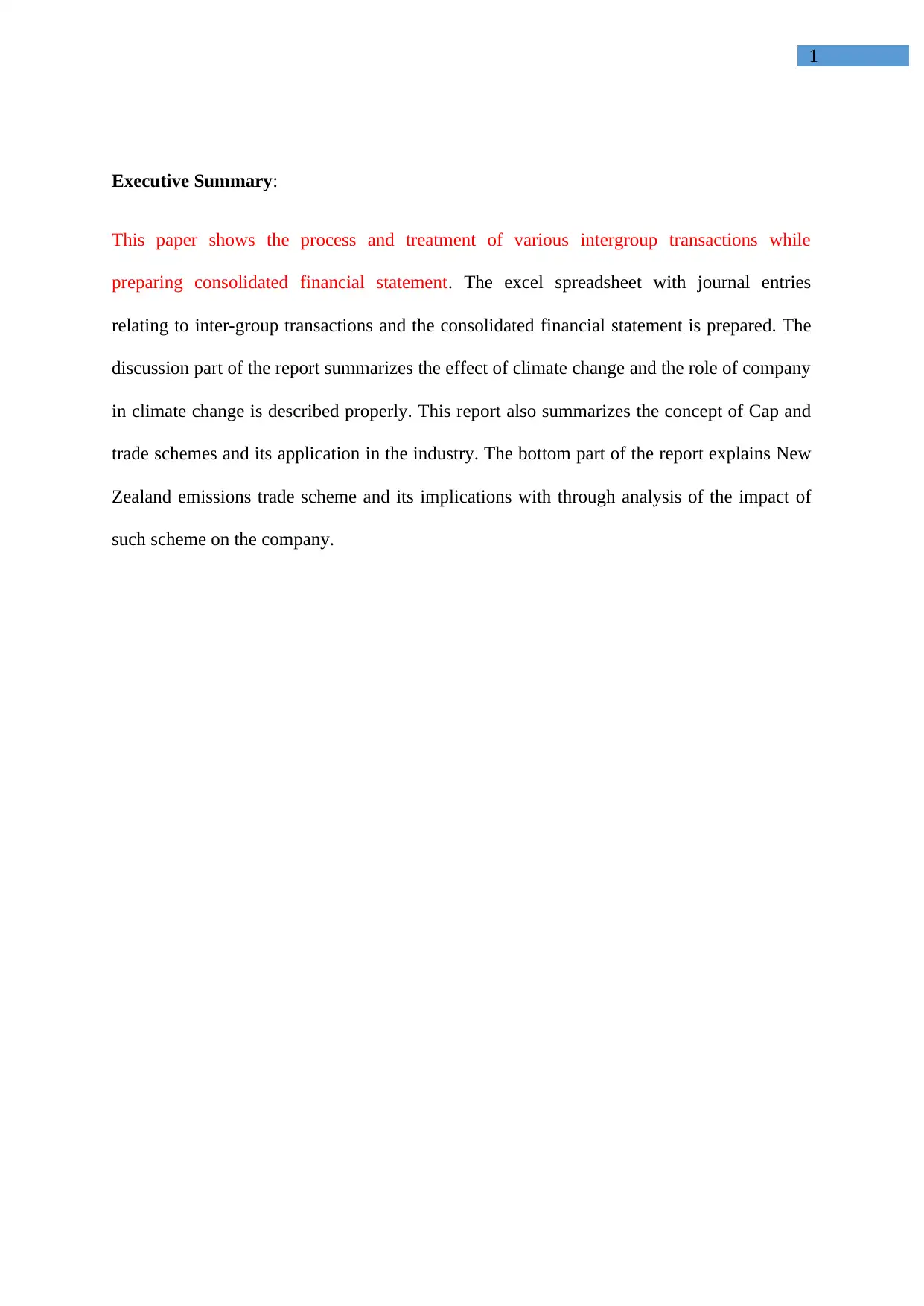
1
Executive Summary:
This paper shows the process and treatment of various intergroup transactions while
preparing consolidated financial statement. The excel spreadsheet with journal entries
relating to inter-group transactions and the consolidated financial statement is prepared. The
discussion part of the report summarizes the effect of climate change and the role of company
in climate change is described properly. This report also summarizes the concept of Cap and
trade schemes and its application in the industry. The bottom part of the report explains New
Zealand emissions trade scheme and its implications with through analysis of the impact of
such scheme on the company.
Executive Summary:
This paper shows the process and treatment of various intergroup transactions while
preparing consolidated financial statement. The excel spreadsheet with journal entries
relating to inter-group transactions and the consolidated financial statement is prepared. The
discussion part of the report summarizes the effect of climate change and the role of company
in climate change is described properly. This report also summarizes the concept of Cap and
trade schemes and its application in the industry. The bottom part of the report explains New
Zealand emissions trade scheme and its implications with through analysis of the impact of
such scheme on the company.
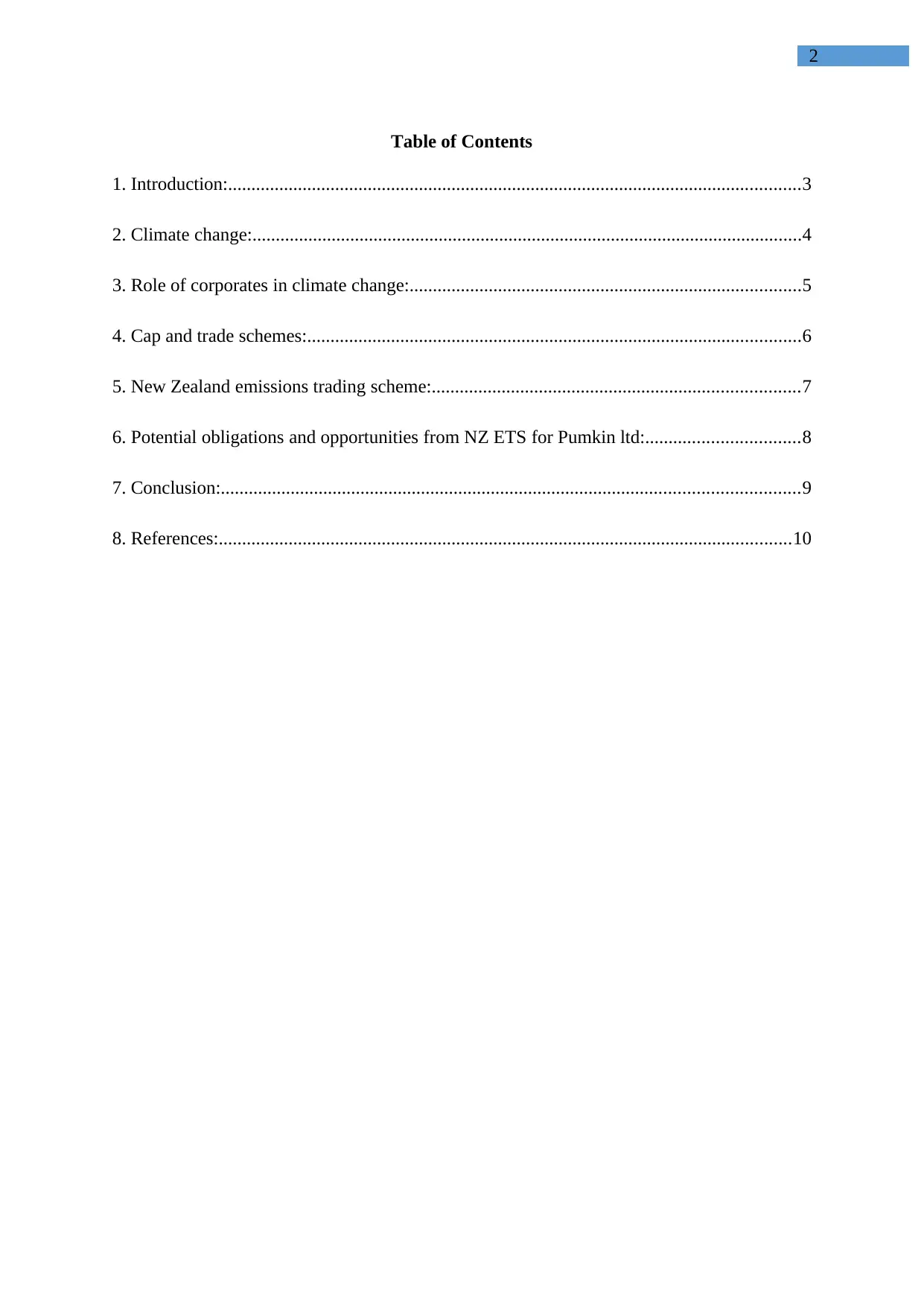
2
Table of Contents
1. Introduction:...........................................................................................................................3
2. Climate change:......................................................................................................................4
3. Role of corporates in climate change:....................................................................................5
4. Cap and trade schemes:..........................................................................................................6
5. New Zealand emissions trading scheme:...............................................................................7
6. Potential obligations and opportunities from NZ ETS for Pumkin ltd:.................................8
7. Conclusion:............................................................................................................................9
8. References:...........................................................................................................................10
Table of Contents
1. Introduction:...........................................................................................................................3
2. Climate change:......................................................................................................................4
3. Role of corporates in climate change:....................................................................................5
4. Cap and trade schemes:..........................................................................................................6
5. New Zealand emissions trading scheme:...............................................................................7
6. Potential obligations and opportunities from NZ ETS for Pumkin ltd:.................................8
7. Conclusion:............................................................................................................................9
8. References:...........................................................................................................................10
⊘ This is a preview!⊘
Do you want full access?
Subscribe today to unlock all pages.

Trusted by 1+ million students worldwide
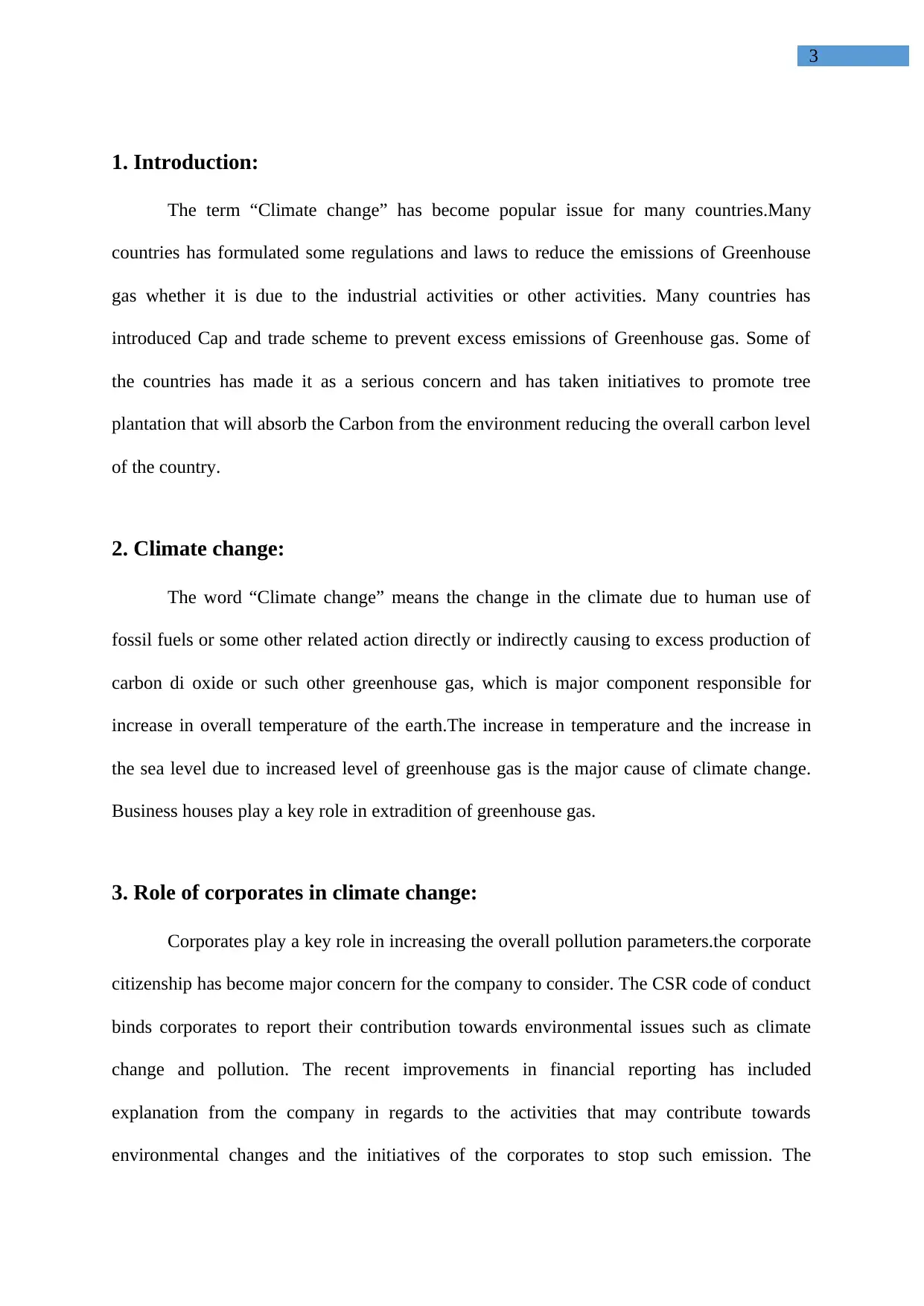
3
1. Introduction:
The term “Climate change” has become popular issue for many countries.Many
countries has formulated some regulations and laws to reduce the emissions of Greenhouse
gas whether it is due to the industrial activities or other activities. Many countries has
introduced Cap and trade scheme to prevent excess emissions of Greenhouse gas. Some of
the countries has made it as a serious concern and has taken initiatives to promote tree
plantation that will absorb the Carbon from the environment reducing the overall carbon level
of the country.
2. Climate change:
The word “Climate change” means the change in the climate due to human use of
fossil fuels or some other related action directly or indirectly causing to excess production of
carbon di oxide or such other greenhouse gas, which is major component responsible for
increase in overall temperature of the earth.The increase in temperature and the increase in
the sea level due to increased level of greenhouse gas is the major cause of climate change.
Business houses play a key role in extradition of greenhouse gas.
3. Role of corporates in climate change:
Corporates play a key role in increasing the overall pollution parameters.the corporate
citizenship has become major concern for the company to consider. The CSR code of conduct
binds corporates to report their contribution towards environmental issues such as climate
change and pollution. The recent improvements in financial reporting has included
explanation from the company in regards to the activities that may contribute towards
environmental changes and the initiatives of the corporates to stop such emission. The
1. Introduction:
The term “Climate change” has become popular issue for many countries.Many
countries has formulated some regulations and laws to reduce the emissions of Greenhouse
gas whether it is due to the industrial activities or other activities. Many countries has
introduced Cap and trade scheme to prevent excess emissions of Greenhouse gas. Some of
the countries has made it as a serious concern and has taken initiatives to promote tree
plantation that will absorb the Carbon from the environment reducing the overall carbon level
of the country.
2. Climate change:
The word “Climate change” means the change in the climate due to human use of
fossil fuels or some other related action directly or indirectly causing to excess production of
carbon di oxide or such other greenhouse gas, which is major component responsible for
increase in overall temperature of the earth.The increase in temperature and the increase in
the sea level due to increased level of greenhouse gas is the major cause of climate change.
Business houses play a key role in extradition of greenhouse gas.
3. Role of corporates in climate change:
Corporates play a key role in increasing the overall pollution parameters.the corporate
citizenship has become major concern for the company to consider. The CSR code of conduct
binds corporates to report their contribution towards environmental issues such as climate
change and pollution. The recent improvements in financial reporting has included
explanation from the company in regards to the activities that may contribute towards
environmental changes and the initiatives of the corporates to stop such emission. The
Paraphrase This Document
Need a fresh take? Get an instant paraphrase of this document with our AI Paraphraser
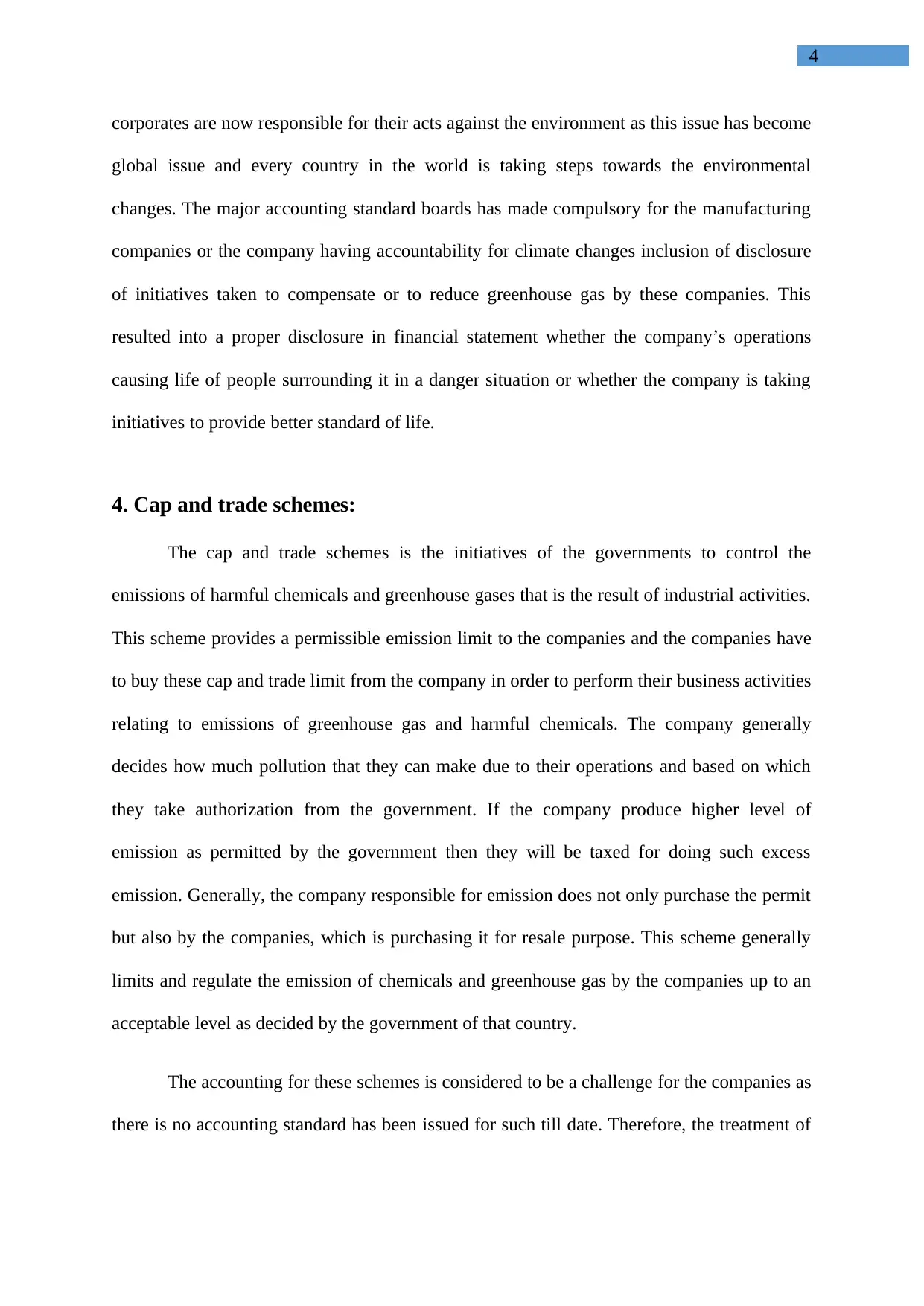
4
corporates are now responsible for their acts against the environment as this issue has become
global issue and every country in the world is taking steps towards the environmental
changes. The major accounting standard boards has made compulsory for the manufacturing
companies or the company having accountability for climate changes inclusion of disclosure
of initiatives taken to compensate or to reduce greenhouse gas by these companies. This
resulted into a proper disclosure in financial statement whether the company’s operations
causing life of people surrounding it in a danger situation or whether the company is taking
initiatives to provide better standard of life.
4. Cap and trade schemes:
The cap and trade schemes is the initiatives of the governments to control the
emissions of harmful chemicals and greenhouse gases that is the result of industrial activities.
This scheme provides a permissible emission limit to the companies and the companies have
to buy these cap and trade limit from the company in order to perform their business activities
relating to emissions of greenhouse gas and harmful chemicals. The company generally
decides how much pollution that they can make due to their operations and based on which
they take authorization from the government. If the company produce higher level of
emission as permitted by the government then they will be taxed for doing such excess
emission. Generally, the company responsible for emission does not only purchase the permit
but also by the companies, which is purchasing it for resale purpose. This scheme generally
limits and regulate the emission of chemicals and greenhouse gas by the companies up to an
acceptable level as decided by the government of that country.
The accounting for these schemes is considered to be a challenge for the companies as
there is no accounting standard has been issued for such till date. Therefore, the treatment of
corporates are now responsible for their acts against the environment as this issue has become
global issue and every country in the world is taking steps towards the environmental
changes. The major accounting standard boards has made compulsory for the manufacturing
companies or the company having accountability for climate changes inclusion of disclosure
of initiatives taken to compensate or to reduce greenhouse gas by these companies. This
resulted into a proper disclosure in financial statement whether the company’s operations
causing life of people surrounding it in a danger situation or whether the company is taking
initiatives to provide better standard of life.
4. Cap and trade schemes:
The cap and trade schemes is the initiatives of the governments to control the
emissions of harmful chemicals and greenhouse gases that is the result of industrial activities.
This scheme provides a permissible emission limit to the companies and the companies have
to buy these cap and trade limit from the company in order to perform their business activities
relating to emissions of greenhouse gas and harmful chemicals. The company generally
decides how much pollution that they can make due to their operations and based on which
they take authorization from the government. If the company produce higher level of
emission as permitted by the government then they will be taxed for doing such excess
emission. Generally, the company responsible for emission does not only purchase the permit
but also by the companies, which is purchasing it for resale purpose. This scheme generally
limits and regulate the emission of chemicals and greenhouse gas by the companies up to an
acceptable level as decided by the government of that country.
The accounting for these schemes is considered to be a challenge for the companies as
there is no accounting standard has been issued for such till date. Therefore, the treatment of
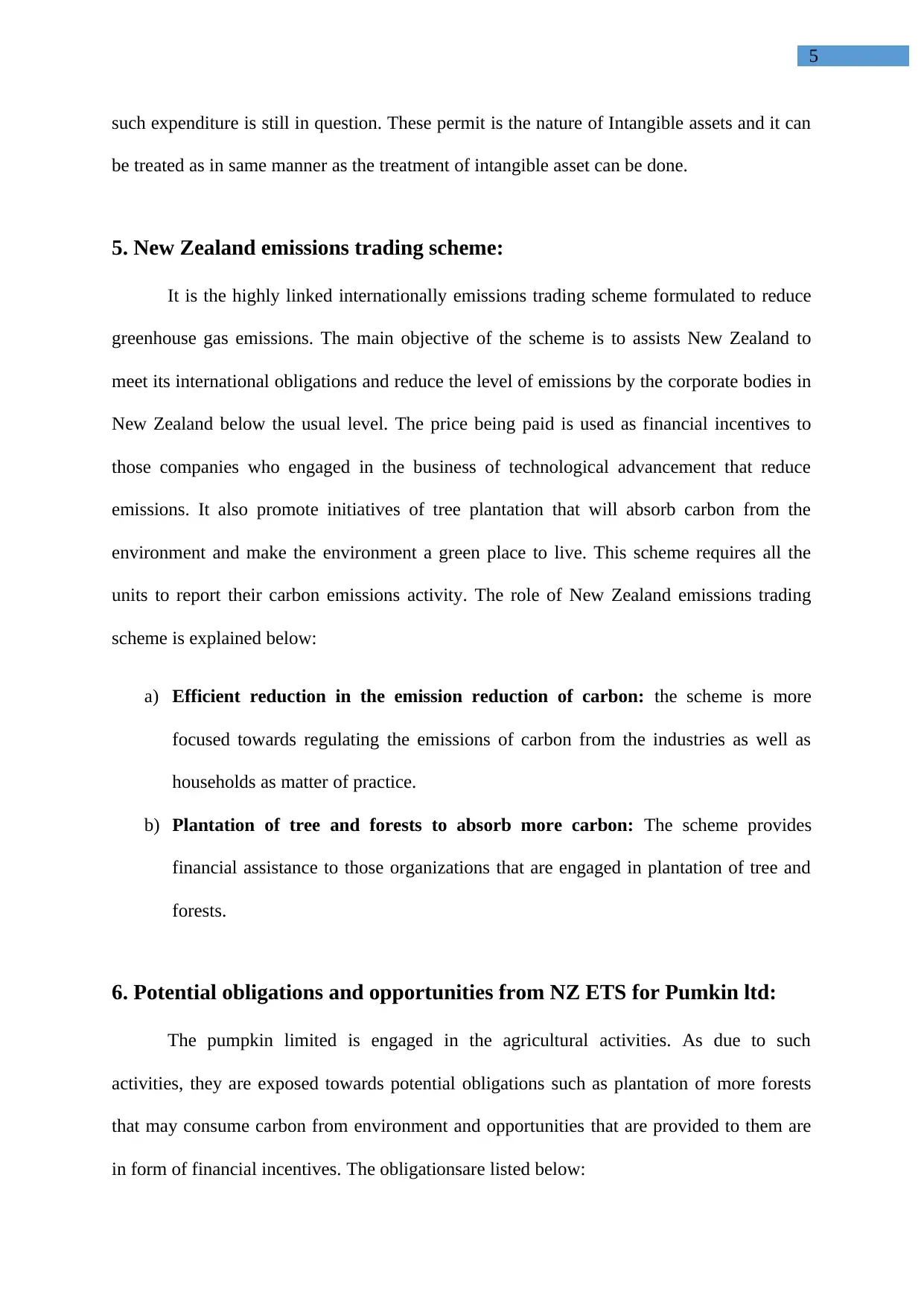
5
such expenditure is still in question. These permit is the nature of Intangible assets and it can
be treated as in same manner as the treatment of intangible asset can be done.
5. New Zealand emissions trading scheme:
It is the highly linked internationally emissions trading scheme formulated to reduce
greenhouse gas emissions. The main objective of the scheme is to assists New Zealand to
meet its international obligations and reduce the level of emissions by the corporate bodies in
New Zealand below the usual level. The price being paid is used as financial incentives to
those companies who engaged in the business of technological advancement that reduce
emissions. It also promote initiatives of tree plantation that will absorb carbon from the
environment and make the environment a green place to live. This scheme requires all the
units to report their carbon emissions activity. The role of New Zealand emissions trading
scheme is explained below:
a) Efficient reduction in the emission reduction of carbon: the scheme is more
focused towards regulating the emissions of carbon from the industries as well as
households as matter of practice.
b) Plantation of tree and forests to absorb more carbon: The scheme provides
financial assistance to those organizations that are engaged in plantation of tree and
forests.
6. Potential obligations and opportunities from NZ ETS for Pumkin ltd:
The pumpkin limited is engaged in the agricultural activities. As due to such
activities, they are exposed towards potential obligations such as plantation of more forests
that may consume carbon from environment and opportunities that are provided to them are
in form of financial incentives. The obligationsare listed below:
such expenditure is still in question. These permit is the nature of Intangible assets and it can
be treated as in same manner as the treatment of intangible asset can be done.
5. New Zealand emissions trading scheme:
It is the highly linked internationally emissions trading scheme formulated to reduce
greenhouse gas emissions. The main objective of the scheme is to assists New Zealand to
meet its international obligations and reduce the level of emissions by the corporate bodies in
New Zealand below the usual level. The price being paid is used as financial incentives to
those companies who engaged in the business of technological advancement that reduce
emissions. It also promote initiatives of tree plantation that will absorb carbon from the
environment and make the environment a green place to live. This scheme requires all the
units to report their carbon emissions activity. The role of New Zealand emissions trading
scheme is explained below:
a) Efficient reduction in the emission reduction of carbon: the scheme is more
focused towards regulating the emissions of carbon from the industries as well as
households as matter of practice.
b) Plantation of tree and forests to absorb more carbon: The scheme provides
financial assistance to those organizations that are engaged in plantation of tree and
forests.
6. Potential obligations and opportunities from NZ ETS for Pumkin ltd:
The pumpkin limited is engaged in the agricultural activities. As due to such
activities, they are exposed towards potential obligations such as plantation of more forests
that may consume carbon from environment and opportunities that are provided to them are
in form of financial incentives. The obligationsare listed below:
⊘ This is a preview!⊘
Do you want full access?
Subscribe today to unlock all pages.

Trusted by 1+ million students worldwide

6
a) The horticulturists should not deforest the land that have been used by the company
for horticulture purpose.
b) The company should perform proper recycling mechanisms instead of burning them.
c) The company should export carbon intensive products instead of consuming
internally.
However, as there are some opportunities for the company due to NZ ETS, which is mainly
in the form of financial assistance or incentives provided to them.
a) The horticulturists should not deforest the land that have been used by the company
for horticulture purpose.
b) The company should perform proper recycling mechanisms instead of burning them.
c) The company should export carbon intensive products instead of consuming
internally.
However, as there are some opportunities for the company due to NZ ETS, which is mainly
in the form of financial assistance or incentives provided to them.
Paraphrase This Document
Need a fresh take? Get an instant paraphrase of this document with our AI Paraphraser
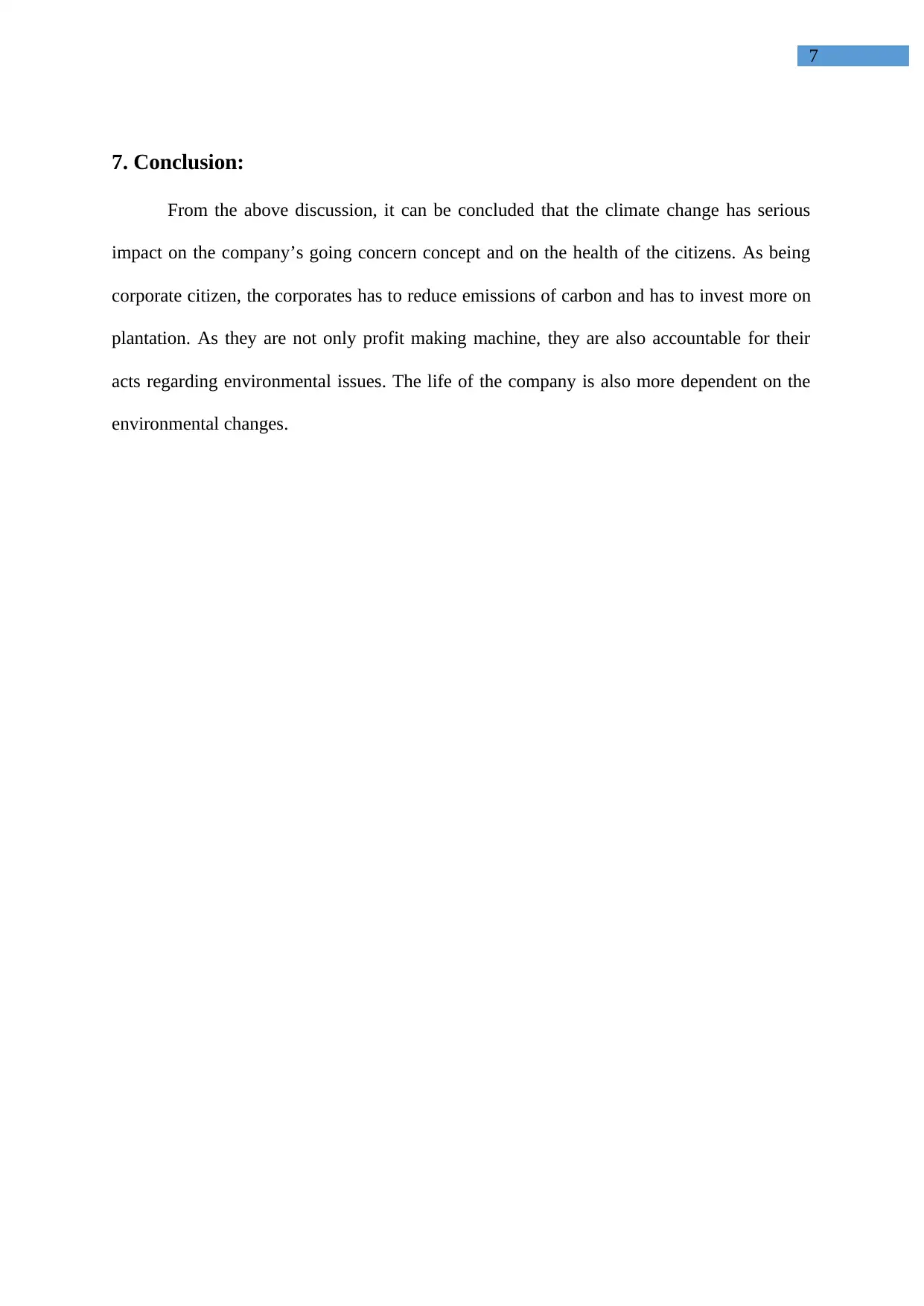
7
7. Conclusion:
From the above discussion, it can be concluded that the climate change has serious
impact on the company’s going concern concept and on the health of the citizens. As being
corporate citizen, the corporates has to reduce emissions of carbon and has to invest more on
plantation. As they are not only profit making machine, they are also accountable for their
acts regarding environmental issues. The life of the company is also more dependent on the
environmental changes.
7. Conclusion:
From the above discussion, it can be concluded that the climate change has serious
impact on the company’s going concern concept and on the health of the citizens. As being
corporate citizen, the corporates has to reduce emissions of carbon and has to invest more on
plantation. As they are not only profit making machine, they are also accountable for their
acts regarding environmental issues. The life of the company is also more dependent on the
environmental changes.
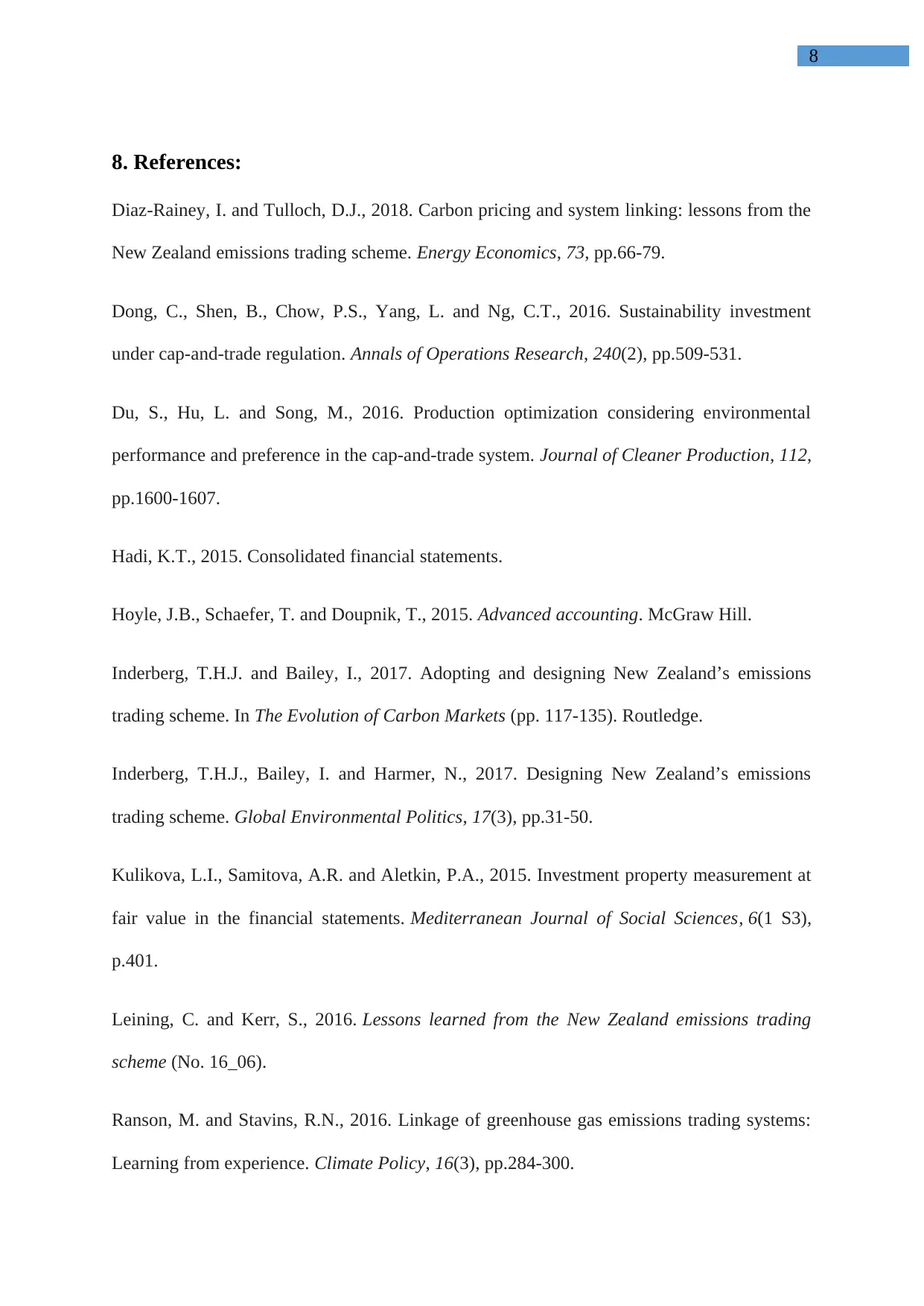
8
8. References:
Diaz-Rainey, I. and Tulloch, D.J., 2018. Carbon pricing and system linking: lessons from the
New Zealand emissions trading scheme. Energy Economics, 73, pp.66-79.
Dong, C., Shen, B., Chow, P.S., Yang, L. and Ng, C.T., 2016. Sustainability investment
under cap-and-trade regulation. Annals of Operations Research, 240(2), pp.509-531.
Du, S., Hu, L. and Song, M., 2016. Production optimization considering environmental
performance and preference in the cap-and-trade system. Journal of Cleaner Production, 112,
pp.1600-1607.
Hadi, K.T., 2015. Consolidated financial statements.
Hoyle, J.B., Schaefer, T. and Doupnik, T., 2015. Advanced accounting. McGraw Hill.
Inderberg, T.H.J. and Bailey, I., 2017. Adopting and designing New Zealand’s emissions
trading scheme. In The Evolution of Carbon Markets (pp. 117-135). Routledge.
Inderberg, T.H.J., Bailey, I. and Harmer, N., 2017. Designing New Zealand’s emissions
trading scheme. Global Environmental Politics, 17(3), pp.31-50.
Kulikova, L.I., Samitova, A.R. and Aletkin, P.A., 2015. Investment property measurement at
fair value in the financial statements. Mediterranean Journal of Social Sciences, 6(1 S3),
p.401.
Leining, C. and Kerr, S., 2016. Lessons learned from the New Zealand emissions trading
scheme (No. 16_06).
Ranson, M. and Stavins, R.N., 2016. Linkage of greenhouse gas emissions trading systems:
Learning from experience. Climate Policy, 16(3), pp.284-300.
8. References:
Diaz-Rainey, I. and Tulloch, D.J., 2018. Carbon pricing and system linking: lessons from the
New Zealand emissions trading scheme. Energy Economics, 73, pp.66-79.
Dong, C., Shen, B., Chow, P.S., Yang, L. and Ng, C.T., 2016. Sustainability investment
under cap-and-trade regulation. Annals of Operations Research, 240(2), pp.509-531.
Du, S., Hu, L. and Song, M., 2016. Production optimization considering environmental
performance and preference in the cap-and-trade system. Journal of Cleaner Production, 112,
pp.1600-1607.
Hadi, K.T., 2015. Consolidated financial statements.
Hoyle, J.B., Schaefer, T. and Doupnik, T., 2015. Advanced accounting. McGraw Hill.
Inderberg, T.H.J. and Bailey, I., 2017. Adopting and designing New Zealand’s emissions
trading scheme. In The Evolution of Carbon Markets (pp. 117-135). Routledge.
Inderberg, T.H.J., Bailey, I. and Harmer, N., 2017. Designing New Zealand’s emissions
trading scheme. Global Environmental Politics, 17(3), pp.31-50.
Kulikova, L.I., Samitova, A.R. and Aletkin, P.A., 2015. Investment property measurement at
fair value in the financial statements. Mediterranean Journal of Social Sciences, 6(1 S3),
p.401.
Leining, C. and Kerr, S., 2016. Lessons learned from the New Zealand emissions trading
scheme (No. 16_06).
Ranson, M. and Stavins, R.N., 2016. Linkage of greenhouse gas emissions trading systems:
Learning from experience. Climate Policy, 16(3), pp.284-300.
⊘ This is a preview!⊘
Do you want full access?
Subscribe today to unlock all pages.

Trusted by 1+ million students worldwide

9
Schuur, E.A., McGuire, A.D., Schädel, C., Grosse, G., Harden, J.W., Hayes, D.J., Hugelius,
G., Koven, C.D., Kuhry, P., Lawrence, D.M. and Natali, S.M., 2015. Climate change and the
permafrost carbon feedback. Nature, 520(7546), p.171.
Urry, J., 2015. Climate change and society. In Why the social sciences matter (pp. 45-59).
Palgrave Macmillan, London.
Schuur, E.A., McGuire, A.D., Schädel, C., Grosse, G., Harden, J.W., Hayes, D.J., Hugelius,
G., Koven, C.D., Kuhry, P., Lawrence, D.M. and Natali, S.M., 2015. Climate change and the
permafrost carbon feedback. Nature, 520(7546), p.171.
Urry, J., 2015. Climate change and society. In Why the social sciences matter (pp. 45-59).
Palgrave Macmillan, London.
Paraphrase This Document
Need a fresh take? Get an instant paraphrase of this document with our AI Paraphraser

10
Appendix:
Appendix:

11
⊘ This is a preview!⊘
Do you want full access?
Subscribe today to unlock all pages.

Trusted by 1+ million students worldwide
1 out of 13
Related Documents
Your All-in-One AI-Powered Toolkit for Academic Success.
+13062052269
info@desklib.com
Available 24*7 on WhatsApp / Email
![[object Object]](/_next/static/media/star-bottom.7253800d.svg)
Unlock your academic potential
Copyright © 2020–2025 A2Z Services. All Rights Reserved. Developed and managed by ZUCOL.





